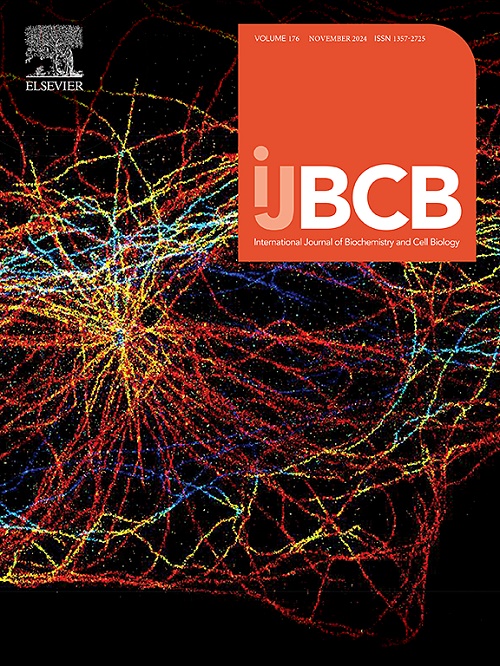Inhibition of ERO1A by TCF21 curbs aerobic glycolysis and enhances immune recognition in lung adenocarcinoma
IF 2.8
3区 生物学
Q2 BIOCHEMISTRY & MOLECULAR BIOLOGY
International Journal of Biochemistry & Cell Biology
Pub Date : 2025-07-12
DOI:10.1016/j.biocel.2025.106831
引用次数: 0
Abstract
Background
Among the many malignancies, lung adenocarcinoma (LUAD) is a top global health and life risk. The focus of this research is to explore how the TCF21/ERO1A pathway influences the immune escape mechanisms triggered by aerobic glycolysis in LUAD.
Methods
After downloading mRNA expression data from TCGA-LUAD and conducting differential expression analysis, we identified our target mRNA based on literature review. We used the hTFtarget database to forecast the upstream transcription factor (TF) of the target mRNA, and their binding relationship was verified through dual-luciferase experiments. Gene set enrichment analysis (GSEA) was performed on the target gene to probe its impact on LUAD-associated signaling pathways. qRT-PCR was used to detect the expression of ERO1A, TCF21, and PD-L1 mRNA. Western blot was employed to measure the expression levels of glycolysis-related proteins (SLC2A1, HK2, LDHA) and PD-L1 protein. Extracellular acidification rate and oxygen consumption rate were evaluated using a Seahorse metabolic analyzer. The apoptosis of CD8+ T cells and the activation status of CD8+ T cells were detected by flow cytometry. We also conducted 3-(4,5-dimethylthiazol-2-yl)-2,5-diphenyltetrazolium (MTT) assay to assess the cytotoxicity of natural killer cells against LUAD cells.
Results
High expression levels of ERO1A were observed in LUAD tissues and cells. GSEA identified a notable association of ERO1A with glycolytic processes and tumor immune evasion pathways. The depletion of ERO1A deeply impaired the glycolytic capacity, immune evasion abilities, and PD-L1 expression in LUAD cells, as validated by both cellular and molecular experiments. ERO1A induced immune evasion in LUAD cells via the upregulation of PD-L1. TCF21, an upstream regulator of ERO1A, was found to be downregulated in LUAD. Dual-luciferase assays also provided evidence for the specific binding of ERO1A to TCF21. Recovery experiments showed TCF21 curbed the stimulatory effect of glycolysis on the immune evasion of LUAD cells by suppressing ERO1A expression.
Conclusion
TCF21 directs its action towards ERO1A, thereby inhibiting the glycolysis-mediated promotion of immune evasion in LUAD cells. As such, the TCF21/ERO1A axis could be harnessed as a therapeutic target and a prognosis marker in LUAD.
TCF21抑制ERO1A抑制肺腺癌的有氧糖酵解并增强免疫识别。
背景:在众多恶性肿瘤中,肺腺癌(LUAD)是全球最大的健康和生命风险。本研究的重点是探讨TCF21/ERO1A途径如何影响LUAD中有氧糖酵解引发的免疫逃逸机制。方法:从TCGA-LUAD下载mRNA表达数据并进行差异表达分析后,通过文献查阅确定目标mRNA。我们利用hTFtarget数据库预测目标mRNA的上游转录因子(TF),并通过双荧光素酶实验验证它们的结合关系。对靶基因进行基因集富集分析(GSEA),探讨其对luad相关信号通路的影响。采用qRT-PCR检测ERO1A、TCF21、PD-L1 mRNA的表达。Western blot检测糖酵解相关蛋白(SLC2A1、HK2、LDHA)和PD-L1蛋白的表达水平。使用海马代谢分析仪评估细胞外酸化速率和耗氧量。流式细胞术检测CD8+ T细胞凋亡及活化状态。我们还进行了3-(4,5-二甲基噻唑-2-基)-2,5-二苯四唑(MTT)测定,以评估自然杀伤细胞对LUAD细胞的细胞毒性。结果:ERO1A在LUAD组织和细胞中高表达。GSEA发现了ERO1A与糖酵解过程和肿瘤免疫逃避途径的显著关联。经细胞和分子实验证实,ERO1A的缺失严重损害了LUAD细胞的糖酵解能力、免疫逃避能力和PD-L1表达。ERO1A通过上调PD-L1诱导LUAD细胞的免疫逃避。TCF21是ERO1A的上游调控因子,在LUAD中被发现下调。双荧光素酶测定也提供了ERO1A与TCF21特异性结合的证据。恢复实验表明,TCF21通过抑制ERO1A表达抑制糖酵解对LUAD细胞免疫逃避的刺激作用。结论:TCF21直接作用于ERO1A,从而抑制糖酵解介导的LUAD细胞免疫逃避。因此,TCF21/ERO1A轴可以作为LUAD的治疗靶点和预后标志物。
本文章由计算机程序翻译,如有差异,请以英文原文为准。
求助全文
约1分钟内获得全文
求助全文
来源期刊
CiteScore
8.10
自引率
0.00%
发文量
124
审稿时长
19 days
期刊介绍:
IJBCB publishes original research articles, invited reviews and in-focus articles in all areas of cell and molecular biology and biomedical research.
Topics of interest include, but are not limited to:
-Mechanistic studies of cells, cell organelles, sub-cellular molecular pathways and metabolism
-Novel insights into disease pathogenesis
-Nanotechnology with implication to biological and medical processes
-Genomics and bioinformatics

 求助内容:
求助内容: 应助结果提醒方式:
应助结果提醒方式:


